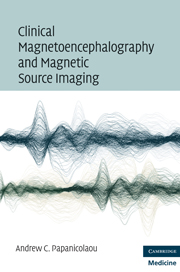Book contents
- Frontmatter
- Contents
- Contributors
- Preface
- Section 1 The method
- Section 2 Spontaneous brain activity
- Section 3 Evoked magnetic fields
- Postscript: Future applications of clinical MEG
- Overview
- Normal aging and neurodegenerative disorders
- Neurodevelopmental disorders
- Psychiatric disorders
- Neurological disorders
- Functional reorganization
- References
- Index
Functional reorganization
from Postscript: Future applications of clinical MEG
Published online by Cambridge University Press: 01 March 2010
- Frontmatter
- Contents
- Contributors
- Preface
- Section 1 The method
- Section 2 Spontaneous brain activity
- Section 3 Evoked magnetic fields
- Postscript: Future applications of clinical MEG
- Overview
- Normal aging and neurodegenerative disorders
- Neurodevelopmental disorders
- Psychiatric disorders
- Neurological disorders
- Functional reorganization
- References
- Index
Summary
Cerebrovascular disease
The use of MEG in documenting brain plasticity for sensorimotor functions following stroke has been demonstrated in several studies by Rossini and colleagues. They showed the reorganization of the early M20 and M30 somatosensory evoked-response sources and explored its relationship to clinical outcomes. In an investigation of individuals recovering from stroke, Rossini and coworkers found significant alterations in the location and latency of the M20 and M30 source generators in the primary sensory hand area of the affected and, to a lesser extent, unaffected hemispheres, though more favorable outcomes were correlated with reorganization within the ipsilesional hemisphere. Studies by Tecchio and coworkers have reaffirmed this earlier finding in both chronic and acute stoke patients by reporting positive correlations between reorganization of M20 and M30 cortical sources in the perirolandic region of the affected hemisphere and recovery of hand function.
MEG has not only been used to measure cortical reorganization for sensorimotor functions but has also been applied to monitor neural plasticity related to receptive language function following recovery from stroke. In a study of individuals with chronic aphasia secondary to left-hemisphere ischemic stroke, Breier and coworkers observed that receptive language functions were predominantly reorganized to areas outside the classic Wernicke's region in the ipsilesional hemisphere as opposed to the unaffected hemisphere. These authors also reported that improved clinical outcome was associated with normalization of activity in putative premorbid receptive language regions, in contrast to activity reorganized in perilesional areas outside premorbid language areas that may become involved in language after aphasia secondary to stroke. Reorganization of receptive language regions in chronic aphasic patients has been studied systematically in the context of constraint-induced language therapy.
- Type
- Chapter
- Information
- Clinical Magnetoencephalography and Magnetic Source Imaging , pp. 190 - 191Publisher: Cambridge University PressPrint publication year: 2009



